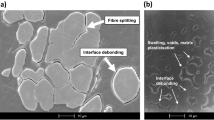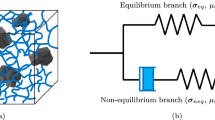The effects related to the evolution of the moisture-dependent hygroelastic properties of composite plies constituting a fiber-reinforced epoxy laminate on the predicted stress states in the structure during the transient stage of hygroscopic loading are investigated. The approach proposed involves the coupling of the classical continuum mechanics formalism to the Eshelby–Kröner self-consistent scale transition model. An inverse scale transition model is used to describe the evolution of local hygroelastic properties of the epoxy matrix as the process of moisture diffusion proceeds. The scale transition relations allow one to determine the local distribution of stresses in the constituents (fiber and matrix) of each ply of the laminates considered from the distribution of macroscopic stresses. Numerical simulations show that the account (or not) of softening of the composite structure under hygroscopic loadings significantly affects the multiscale stress states predicted.
Similar content being viewed by others
References
S. W. Tsai, Composite Design, Think Composites (1987).
A. Agbossou and J. Pastor, “Thermal stresses and thermal expansion coefficients of n-layered fiber-reinforced composites,” Compos. Sci. Technol., 57, 249-260 (1997).
P. D. Soden, M. J. Hinton, and A. S. Kaddour, “Lamina properties lay-up configurations and loading conditions for arange of fiber-reinforced composite laminates,” Compos. Sci. Technol., 58, 1011-1022 (1998).
J. Crank, The Mathematics of Diffusion, Clarendon Press, Ox ford (1975).
B. P. Patel, M. Ganapathi, and D. P. Makhecha, “Hygrothermal effects on the structural behaviour of thick composite laminates using higher-order theory,” Com pos. Struct., 56, 25-34 (2002).
D. E. Bowles, D. Post, C. T. Herakovich, and D. R. Tenney, “Moiré interferometry for thermal expansion of composites,” Exp. Mech., 21, 441-447 (1981).
S. R. A. Dyer, D. Lord, I. J. Hutch in son, I. M. Ward, and R. A. Duckett, “Elastic anisotropy in unidirectional fibre reinforced composites,” J. Phys. D: Appl. Phys., 25, 66-73 (1992).
C. Ferreira, P. Casari, R. Bouzidi, and F. Jacquemin, “Identification of Young’s modulus pro file in PVC foam core thickness using speckle interferom etry and inverse method,” in: Proc. SPIE — The International Society for Optical Engineering (2006).
C. Ferreira, F. Jacquemin, and P. Casari, “Measurement of the nonuniform thermal expansion coefficient of a PVC foam core by speckle interferometry — influence on the mechanical behavior of sandwich structures,” J. Cell. Plast., 42, No. 5, 393-404 (2006).
C. T. Herakovitch, Mechanics of Fibrous Composites, John Wiley & Sons Inc., New York (1998).
G. D. Sims, G. D. Dean, B. E. Read, and B. C. Western, “Assessment of damage in GRP laminates by stress wave emission and dynamic mechanical measurements,” J. Mater. Sci., 12, No. 11, 2329-2342 (1997).
C. L. Tsai and I. M. Daniel, “Measurement of longitudinal shear modulus of single fibers by means of a torsional pendulum,” in: 38th Int. SAMPE Symp. (1993), pp. 1861-1868.
J. A. DiCarlo, “Creep of chemically vapor deposited SiC fiber,” J. Mater. Sci., 21, 217-224 (1986).
C. L. Tsai and C. H. Chiang, “Characterization of the hygric behavior of single fibers,” Compos. Sci. Technol., 60, 2725-2729 (2000).
S. Fréour, D. Gloaguen, M. Francois, R. Guillén, E. Girard, and J. Bouillo, “Determination of the macroscopic elastic constants of a phase embedded in a multiphase polycrystal — application to the beta-phase of Ti-17 titanium based alloy,” Ma ter. Sci. Forum, 404-407, 723-728 (2002).
S. Fréour, D. Gloaguen, M. Francois, A. Perronnet, and R. Guillén, “Estimation of Ti-17 β-phase single-crystal elasticity constants using X-ray diffraction measurements and inverse scale transition modelling,” J. Appl. Crystallogr., 38, 30-37 (2005).
S. Fréour, D. Gloaguen, M. Francois, and R. Guillén, “Application of inverse models and XRD anal y sis to the de termination of Ti-17 β-phase coefficients of thermal expansion,” Scripta Mater., 54, 1475-1478 (2006).
S. Fréour, D. Gloaguen, M. Francois, and R. Guillén, “Study of the coefficients of thermal expansion of phases embedded in multiphase materials,” Mater. Sci. Forum, 426-432, 2083-2088 (2003).
S. Fréour, D. Gloaguen, M. Francois, and R. Guillén, “Thermal properties of polycrystals — X-ray diffraction and scale transition modelling,” Phys. Stat. Solidi (a), 201, 59-71 (2003).
S. Matthies, S. Merkel, H. R. Wenk, R. J. Hemley, and H. Mao, “Effects of texture on the determination of elasticity of polycrystalline e-iron from diffraction measurements,” Earth Planet. Sci. Lett., 194, 201-212 (2001).
J. Han, A. Bertram, J. Olschewski, W. Hermann, and H. G. Sockel, “Identification of elastic constants of alloys with sheet and fibre textures based on resonance measurements and finite element analysis,” Ma ter. Sci. Eng., A191, 105-111 (1995).
W. Voigt, Lehrbuch der Kristallphysik, Teubner, Leipzig–Berlin (1928).
A. Reuss, “Berechnung der Fliessgrenze von Mischkristallen auf Grund der Plastizitätsbedingung für Einkristalle,” Z. Angew. Math. Mech., 9, 49-58 (1929).
H. Neerfeld, “Zur Spannungsberechnung aus röntgenographischen Dehnungsmessungen,” Mitt. Kai ser-Wilhelm-Inst. Eisenforschung Düsseldorf, 24, 61-70 (1942).
R. Hill, “The elastic behaviour of a crystalline aggregate,” Proc. Phys. Soc., 65, 349-354, (1952).
S. W. Tsai and H. T. Hahn, Introduction to Composite Materials, Technomic Publ. Co., Inc., Lancaster, Pennsylvania (1980).
K. Tanaka and T. Mori, “The hardening of crystals by non-deforming particles and fibers,” Acta Metall., 18, 931-941 (1970).
T. Mori and K. Tanaka, “Average stress in matrix and average elastic energy of materials with misfitting inclusions,” Acta Metall., 21, 571-574 (1973).
J. D. Eshelby, “The determination of the elastic field of an ellipsoidal inclusion, and related problems,” Proc. Roy. Soc. London, A241, 376-396 (1957).
E. Kröner, “Berechnung der elastischen Konstanten des Vielkristalls aus des Konstanten des Einkristalls,” Z. Phys., 151, 504-518 (1958).
F. Jacquemin, S. Fréour, and R. Guillén, “A self-consistent approach for transient hygroscopic stresses and moisture expansion coefficients of fiber-reinforced composites,” J. Reinf. Plast. Compos., 24, 485-502 (2005).
A. C. Loos and G. S. Springer, Environmental Effects on Composite Materials, Moisture Absorption of Graphite — Epoxy Composition Immersed in Liquids and in Humid Air, Technomic Publ. (1981), pp. 34-55.
A. Morawiec, “Calculation of polycrystal elastic constants from single-crystal data,” Phys. Stat. Solidi (b), 154, 535-541 (1989).
S. Matthies and M. Humbert, “The realization of the concept of a geometric mean for calculating physical constants of polycrystalline materials,” Phys. Stat. Solidi (b), 177, K47-K50 (1993).
S. Matthies, M. Humbert, and Ch. Schuman, “On the use of the geometric mean approximation in residual stress analysis,” Phys. Stat. Solidi (b), 186, K41-K44 (1994).
U. F. Kocks, C. N. Tome, and H. R. Wenk, Texture and Anisotropy, Cam bridge Univ. Press (1998).
S. Fréour, F. Jacquemin, and R. Guillén, “On the use of the geometric mean approximation in estimating the effective hygro-elastic behaviour of fiber-reinforced composites,” J. Mater. Sci., 47, 7537-7543 (2007).
R. Morris, “Elastic constants of polycrystals,” Int. J. Eng. Sci., 8, 49, (1970).
R. Hill, “Continuum micro-mechanics of elastoplastic polycrystals,” J. Mech. Phys. Solids, 13, 89-101 (1965).
T. Mura, Micromechanics of Defects in Solids, Martinus Nijhoff Publishers, The Hague, Netherlands (1982).
K. S. Sai Ram and P. K. Sinha, “Hygrothermal effects on the bending characteristics of laminated composite plates,” Comput. Struct., 40, No. 4, 1009-1015 (1991).
F. Jacquemin and A. Vautrin, “A closed-form solution for the internal stresses in thick composite cylinders induced by cyclical environmental conditions,” Compos. Struct., 58, 1-9 (2002).
S. Fréour, F. Jacquemin, and R. Guillén, “On an analytical self-consistent model for internal stress prediction in fiber-reinforced composites submitted to hygro-elastic load,” J. Reinf. Plast. Compos., 24, 1365-1377 (2005).
U. Welzel, S. Fréour, and E. J. Mittemeijer, “Direction-dependent elastic grain-interaction models — a comparative study,” Philos. Mag., 85, 2391-2414 (2005).
O. Gillat and L. J. Broutman, “Effect of external stress on moisture diffusion and degradation in a graphite-reinforced epoxy laminate,” in: ASTM STP 658 (1978), pp. 61-83.
Y. Weitsman, “A continuum diffusion model for viscoelastic materials,” J. Phys. Chem., 94, 961-968 (1990).
Y. Weitsman, “Moisture in composites: sorption and damage,” in: K. L. Reifsnider (ed.), Fatigue of Composite Materials, Elsevier Science Publ. (1990), pp. 385-429.
Author information
Authors and Affiliations
Additional information
Russian translation in Mekhanika Kompozitnykh Materialov, Vol. 45, No. 4, pp. 539–554, July–August, 2009.
Rights and permissions
About this article
Cite this article
Youssef, G., Fréour, S. & Jacquemin, F. Effects of moisture-dependent properties of constituents on the hygroscopic stresses in composite structures. Mech Compos Mater 45, 369–380 (2009). https://doi.org/10.1007/s11029-009-9098-1
Received:
Revised:
Published:
Issue Date:
DOI: https://doi.org/10.1007/s11029-009-9098-1




